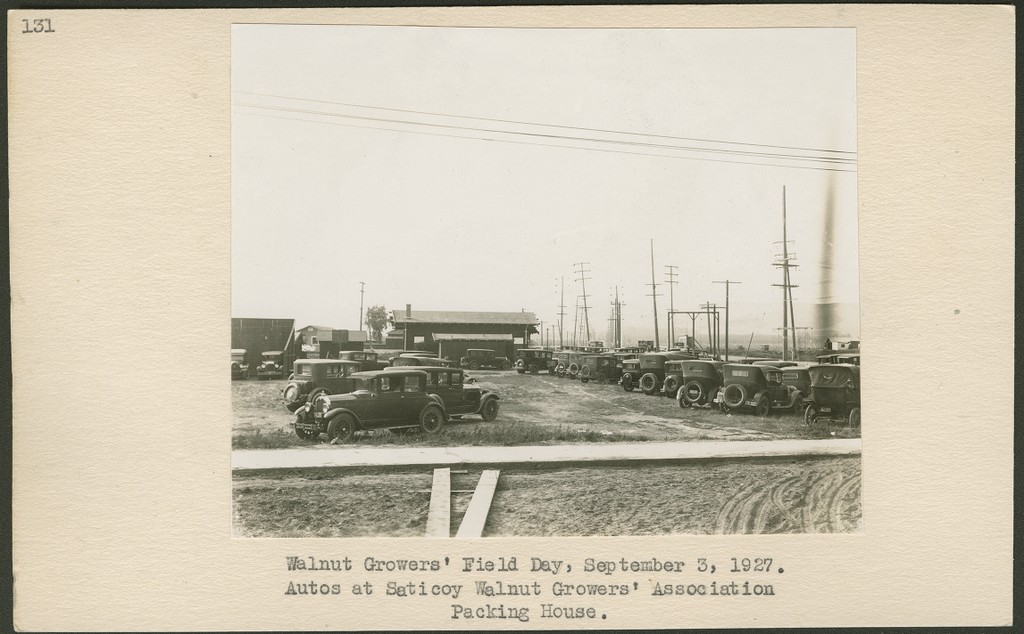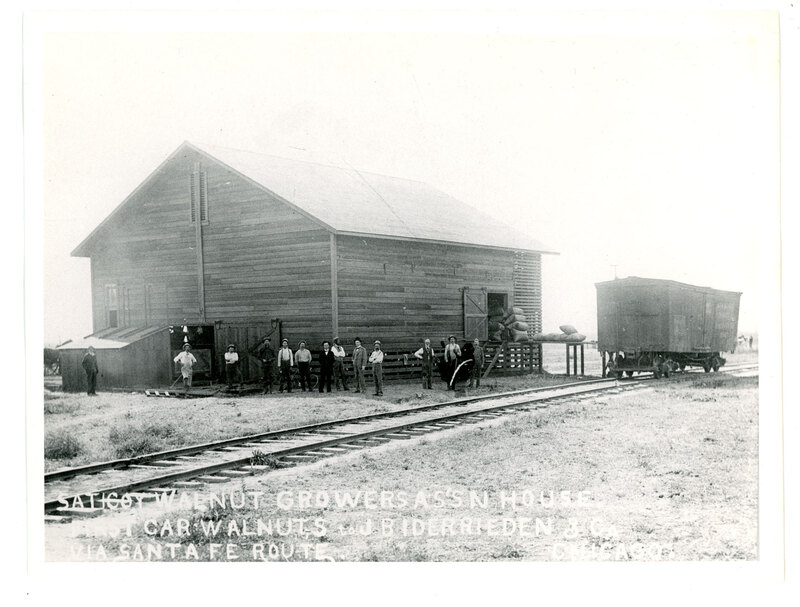Source: Google Maps, 2021.
Ventura County Landmark No. 117: Saticoy Walnut Growers Association Warehouse
Historical Background
The Saticoy Walnut Growers Association Warehouse, designated Ventura County Landmark No. 117, was built in 1919 in response to the rapid expansion of the walnut industry in California. Eugene C. Kimball, a local resident, developed an innovative method for drying walnuts that significantly reduced product losses. The original machinery used in this process still exists inside the warehouse. During this period, Saticoy emerged as a key local shipping point, contributing to the growth of farming cooperatives in California.
The California Walnut Growers Association was established in 1912, with the Saticoy Walnut Growers Association joining shortly thereafter. Leaders in the walnut industry were often influential figures in other agricultural sectors. Notably, Charles Collins Teague, who served as president of both the California Fruit Growers Exchange and the Walnut Growers Association, played a pivotal role in advancing agricultural marketing. Under his leadership, high-grade walnuts were marketed under the “Diamond Brand” label, following a similar strategy to the “Sunkist” branding used for premium citrus products. Teague’s influence extended to the national stage when President Herbert Hoover appointed him to the Federal Farm Board, further solidifying the significance of California’s agricultural cooperatives.
Architectural Significance
The Saticoy Walnut Growers Association Warehouse (#117) and its neighboring structure (#118) are architecturally significant as early examples of utilitarian agricultural buildings designed to meet the demands of a burgeoning industry. Constructed just two years apart, these buildings highlight a deliberate functional design tailored to support large-scale walnut processing and storage. The main warehouse, measuring 80 feet by 200 feet and standing 1.5 stories high, features a gable roof with a widow’s walk, an architectural element that provided both practical ventilation and access for maintenance. The positioning of the warehouse at a 90-degree angle to its adjacent building demonstrates a purposeful layout to optimize workflow and efficiency on the 3.91-acre site.
The addition of an annex in 1921 further reflects the flexibility and adaptability of the structure to accommodate the growing needs of the walnut industry. The heavy wood trusses supporting the warehouse roof exemplify both the craftsmanship and engineering of the period, allowing for large, open interior spaces essential for processing and storage operations. Together, these elements establish the buildings not only as functional industrial structures but also as enduring representations of early 20th-century agricultural architecture in Ventura County.
Impact on the Industry
Seasonal workers were a vital part of the operations at the Saticoy Walnut Growers Association Warehouse, with women tasked with carefully inspecting walnuts for imperfections and determining their quality, while men performed the physically demanding job of loading heavy sacks onto railroads and trucks. From the warehouse, the nuts were transported to Los Angeles, where they were shelled and prepared for distribution.
During the industry’s peak years, around 1956-1957, the warehouse processed an impressive 6,000 tons of walnuts annually, making it the largest walnut facility in the world at the time. However, by 1962, production had declined drastically to just 880 tons. This downturn led to the dissolution of the cooperative, and the land and equipment were sold. As the walnut industry waned, many local farmers shifted their focus to cultivating citrus and avocados, which became dominant crops in the region. Despite these changes, remnants of the warehouse’s history remain intact, with some of the original machinery still preserved inside, serving as a physical reminder of its important role in Ventura County’s agricultural heritage.
Additional Reading
References
Weinstock, C. (1990, December 29). LANDMARKS / COUNTY HISTORICAL SITES: Saticoy Walnut Warehouse Rode a Boom. Los Angeles Times. https://www.latimes.com/archives/la-xpm-1990-12-29-me-6312-story.html
Date Designated: June 1988
Location: 1235-1255 East Wells Road, Saticoy
Photos:
Source: Google Maps, 2025.


